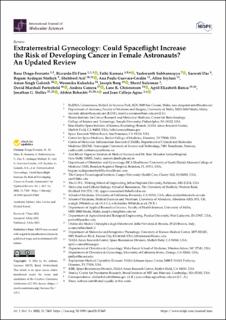| dc.contributor.author | Drago-Ferrante, Rosa | |
| dc.contributor.author | Di Fiore, Riccardo | |
| dc.contributor.author | Karouia, Fathi | |
| dc.contributor.author | Subbannayya, Yashwanth | |
| dc.contributor.author | Das, Saswati | |
| dc.contributor.author | Aydogan Mathyk, Begum | |
| dc.contributor.author | Arif, Shehbeel | |
| dc.contributor.author | Guevara-Cerdán, Ana Paula | |
| dc.contributor.author | Seylani, Allen | |
| dc.contributor.author | Galsinh, Aman Singh | |
| dc.contributor.author | Kukulska, Weronika | |
| dc.contributor.author | Borg, Joseph | |
| dc.contributor.author | Suleiman, Sherif | |
| dc.contributor.author | Porterfield, David Marshall | |
| dc.contributor.author | Camera, Andrea | |
| dc.contributor.author | Christenson, Lane K | |
| dc.contributor.author | Ronca, April Elizabeth | |
| dc.contributor.author | Steller, Jonathan G | |
| dc.contributor.author | Beheshti, Afshin | |
| dc.contributor.author | Calleja-Agius, Jean | |
| dc.date.accessioned | 2023-01-31T10:09:03Z | |
| dc.date.available | 2023-01-31T10:09:03Z | |
| dc.date.created | 2022-08-05T13:34:29Z | |
| dc.date.issued | 2022 | |
| dc.identifier.citation | International Journal of Molecular Sciences. 2022, 23 (13), 7465-?. | en_US |
| dc.identifier.issn | 1661-6596 | |
| dc.identifier.uri | https://hdl.handle.net/11250/3047314 | |
| dc.description.abstract | Outer space is an extremely hostile environment for human life, with ionizing radiation from galactic cosmic rays and microgravity posing the most significant hazards to the health of astronauts. Spaceflight has also been shown to have an impact on established cancer hallmarks, possibly increasing carcinogenic risk. Terrestrially, women have a higher incidence of radiation-induced cancers, largely driven by lung, thyroid, breast, and ovarian cancers, and therefore, historically, they have been permitted to spend significantly less time in space than men. In the present review, we focus on the effects of microgravity and radiation on the female reproductive system, particularly gynecological cancer. The aim is to provide a summary of the research that has been carried out related to the risk of gynecological cancer, highlighting what further studies are needed to pave the way for safer exploration class missions, as well as postflight screening and management of women astronauts following long-duration spaceflight. | en_US |
| dc.language.iso | eng | en_US |
| dc.publisher | MDPI | en_US |
| dc.rights | Navngivelse 4.0 Internasjonal | * |
| dc.rights.uri | http://creativecommons.org/licenses/by/4.0/deed.no | * |
| dc.title | Extraterrestrial Gynecology: Could Spaceflight Increase the Risk of Developing Cancer in Female Astronauts? An Updated Review | en_US |
| dc.title.alternative | Extraterrestrial Gynecology: Could Spaceflight Increase the Risk of Developing Cancer in Female Astronauts? An Updated Review | en_US |
| dc.type | Peer reviewed | en_US |
| dc.type | Journal article | en_US |
| dc.description.version | publishedVersion | en_US |
| dc.source.pagenumber | 7465-? | en_US |
| dc.source.volume | 23 | en_US |
| dc.source.journal | International Journal of Molecular Sciences | en_US |
| dc.source.issue | 13 | en_US |
| dc.identifier.doi | 10.3390/ijms23137465 | |
| dc.identifier.cristin | 2041375 | |
| dc.relation.project | Norges forskningsråd: 223255 | en_US |
| cristin.ispublished | true | |
| cristin.fulltext | original | |
| cristin.qualitycode | 1 | |

